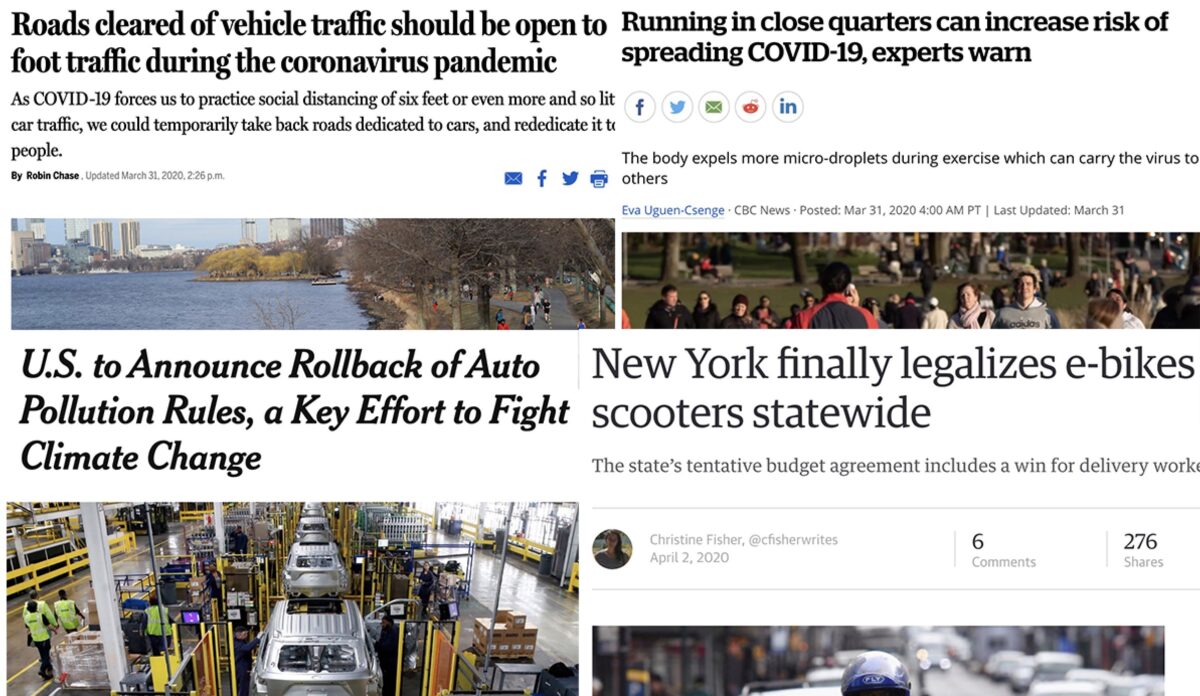
Welcome to the week.
Here are the most noteworthy items our community came across in the past seven days…
Portland’s “green dream” deferred: Curbed took a deep dive into Portland’s planning and transportation work and realized we’ve been resting on laurels for years and have not lived up to our proud legacy of change-making.
Bike shops should be closed: An experienced bike shop employee and former pro mountain biker makes the case that essential workers don’t need bikes, so deeming shops essential is not a risk we should take.
Quiet streets: By far the biggest story in our world this past week was all the calls for re-purposing street space away from driving and towards walking, biking and rolling. Here’s an idea for creating a network of “quiet streets” which are basically beefed-up neighborhood greenways that would work in dense urban areas.
Spreadsheet tracks street changes worldwide: University of North Carolina Researcher Tabitha Combs has created a database on all the cities around the globe that are changing street use policies in the name of social distancing and/or public health concerns.
***
SPONSORED: You can win great prizes and support a pump track in Wilsonville thanks to a grassroots fundraising effort by Willamette Valley Cyclists.
***
Even drivers think it makes sense: Not only does Car & Driver have a level-headed article about using street space for walkers and rollers, a poll at the bottom of their article shows that 75% of their readers think less space for driving is a good trade-off for space for walking.
The wrong rollback: In a bid to boost the economy, Trump will loosen auto fuel standards, a move that will permit cars to emit nearly a billion tons more carbon dioxide than allowable under current regulations.
Thanks to Trump: Early research suggests airborne particles created by auto emissions (among other things) might be linked to higher COVID-19 rates because the virus spreads easier in the dirty air (and/or it strikes people with smog-related lung problems harder).
Advertisement
Open streets in Denver: The Mayor of Denver, Colorado said he’ll ban driving on four streets in order to create more space for people to get outdoors while maintaining a healthy distance from one another.
E-bikes now legal: In what’s being hailed as a big win for delivery workers, New York has finally legalized electric bikes statewide.
A few cones: Temporary bike lanes in New York City made with a few signs and orange cones show that it doesn’t take much to change how streets are used.
Too close for COVID: All over the globe people are realizing that crowded carfree spaces are not just unfair, they are also a public health hazard.
Empty streets, crowded paths: The co-founder of Zipcar wrote in the Boston Globe that due to overcrowded on paths and trails, “We could temporarily take back roads dedicated to cars, and rededicate it to people.”
Tying COVID to the climate: Chicago activist Courtney Cobbs says the change in transportation behaviors we’re seeing right now is a chance to, “transform our transportation system” in a way that makes our planet healthier for future generations.
From the front lines: New York City has the worst virus outbreak and the best transportation advocates. Transportation Alternatives shares a simple guide to how bicycling can help cities cope with COVID-19.
Less distraction: Finally some good news from the car industry: Designers of one of Honda’s new models have decided to go away from the touchscreen trend in order to minimize driver distraction.
— Jonathan Maus: (503) 706-8804, @jonathan_maus on Twitter and jonathan@bikeportland.org
— Get our headlines delivered to your inbox.
— Support this independent community media outlet with a one-time contribution or monthly subscription.


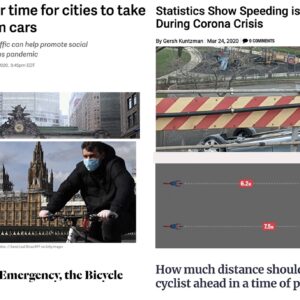
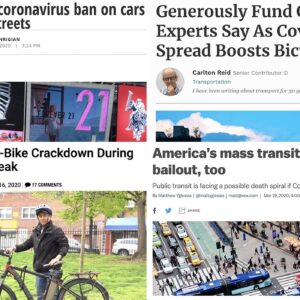
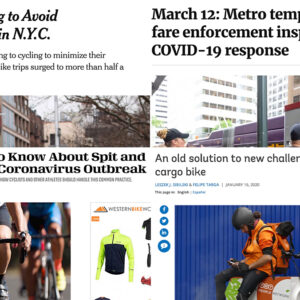
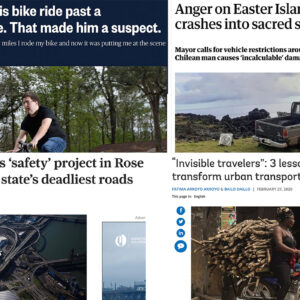
Thanks for reading.
BikePortland has served this community with independent community journalism since 2005. We rely on subscriptions from readers like you to survive. Your financial support is vital in keeping this valuable resource alive and well.
Please subscribe today to strengthen and expand our work.
Bravo Honda–touchscreens should be illegal in automobiles!
Won’t stop some people. I was driving to work the other day (I work in critical infrastructure) and while stopped at a red traffic signal, glanced in my rear view mirror and saw a driver using her laptop computer while at the light (she was holding it high enough that I could see the brand label). She missed the green light because she was too preoccupied.
I have been saying for years that touchscreens and automobiles do not mix, and should have been banned from the start. What’s funny about Honda is that on a lot of their vehicles (including the Fit, HR-V and I think maybe the Civic), the fancier models (EX, EX-L, etc.) have touchscreens, whereas the lower level models (LX) have the older designs that are much safer. I have even read reviews on several Hondas that recommended buyers look at the base trim levels if they can live without the options on the higher trims, specifically because the controls are easier to operate on the base models. I hope they now extend more thoughtful design to the fancier versions with the touchscreens.
On most car brands – and I’ve tried quite a few, as a frequent car renter – the previous generation of entertainment systems had multifunction displays controlled by a knob or two and buttons along the edges of the screen. Sometimes they had overly complex and distracting menu structures – Ford and BMW were particularly notorious – but they were a lot better than touchscreens. You have to look at the screen many times longer to touch it with a finger, versus navigating your finger to a nearby physical button or knob, where you are using touch as much as you are sight to operate the controls.
Another problem is many automakers have tried to come up with a “cleaner” look by eliminating physical radio and HVAC controls, incorporating everything into a single screen. All too often the basic essential controls (volume, changing stations, adjusting fan speed and airflow direction and temperature) aren’t immediately accessible from some menu screens. They should ALWAYS be accessible with a single touch, no matter what – and this can be done on a touchscreen system too, if a certain section of the screen is reserved for these functions. It’s all a matter of good design. I recently rented a Ford Fusion where even the most basic HVAC functions required navigating to the main HVAC screen. Fail!
I’d like to see automakers use a lot more care in designing the interfaces to keep them simple, and only allowing certain functions to be available while the vehicle is in motion. In my Nissan Leaf, many of the EV and trip functions are controlled by buttons to the left of the driver (and thus not controllable by any other passengers), and Nissan has widely disabled access to most of these functions while the vehicle is in motion. While driving I can switch the display mode between range and eMPG and I can adjust the display brightness, but I cannot change the clock or the cabin-preheat timer setting, for example. Most cars should have functions that are selectively disabled like this.
The bike shops non-essential author makes a single big mistake. She translates her experience with how many emt’s and fire responders are car-free, but totaly forgets that those are not the only critical employees. Even more critical ( in some ways) are the folks that still have to go to their jobs running water treatment plants, sewage plants, hardware factories and power plants ( yes they need hardware and parts to build ventilators etc.) In the more urban parts of the country many of these folks need to bike or use public transit. And in this time of Covid ,bikes are certainly the safer alternative to keep these other critical workers on the job. Sheltering at home is a no-go without water or electricity.
Bike shops as “non-essential”: I have one bike and zero cars. I ride the bike to work. Yesterday my rear wheel was stolen while I was at work. At this moment a bike shop is quite essential to me! The alternative would be having one more person burdening the Tri-Met system.
Something also seems a little skewed about the article’s perspective: saying that “not having a vehicle” is “unconscionable” anyway for essential workers, saying that bike-dependent workers just ought to have the spare parts and skills to make their own repairs, etc….
We are not going back to pre-Covid transportation when this is over but I’m not sure it will be for the better. Mass transit is going to be much less popular. Maybe people will bike more but I suspect we will just see more single occupancy cars since people are going to see that as the most virus proof. There is a good chance that pollution is reduced only because fewer people will have jobs. At some point the governments are going to run out of money and we won’t be able to get unemployment checks forever. Either people go back to work sometime soon or the entire world will start looking like Venezuela.
The “ick factor” of being in close proximity to others in a bus is going to take a while to overcome. For that reason, I think we’ve seen peak transit ridership for at least a decade.
If the “ick factor” is true, than we may also not see the return of crowded bars, nightclubs, spectator sports or airline travel.
It’s too soon to tell, but those things seem qualitatively different than riding the bus.
They are different, the mass transit system will save money or be a necessary alternative to the car that got repo’ed during the Covid economic collapse, but NBA tickets or overpriced drinks at a swank nightclub will cost money that many will not have as they struggle to pay several months of accrued rent or catch back up on their credit card debt.
There are other dimensions of difference as well: nightclubs and crowded bars, for example, appeal specifically to the young and covid-invincible.
I agree with you that transit will still be used by people who have no other choices. But I expect that those who do have alternatives will use them. And that’s mostly going to be a car, though I also expect that some who were forced to work at home will continue to do so after the crisis is over in order to skip the commute.
You are right about one aspect of increased car use. One of the reasons people bike or take mass transit is to avoid auto congestion. But for a couple of years after the Covid collapse we will likely see much more open freeways and roads encouraging those who can afford it to drive instead of using alternatives.
So you think that people won’t ride a bus, but they’ll spend 5 hours in a small aluminium tube with 200 other people?
Actually, I do. It’s harder to find alternatives to flying than bussing, and I think airlines are going to work awfully hard to counter any perception that flying is unsafe.
I think we will see a comparable decline in both. Keep in mind that we are entering a recession. People will default on auto loans, and there will be less spare money for vacations. Transit ridership increased during the last recession.
Unfortunately, I think mass transit is held to a different standard than those other activities.
There is also the old stereotype that buses and trains aren’t cleaned regularly or thoroughly enough.
Several grocery stores are advertising that they have crews cleaning & disinfecting throughout the day. Trimet has said they are disinfecting the buses each night, which I would have hoped they were doing in the past.
Regarding “Honda bucks industry trend”, this is great news…other than driver distraction, I worry that these screens vs. analogue gauges will not age well in the interim (10 to 20 years of road life) and make this era’s cars harder to keep going into the future affordably. [Think about how the “average” household appliance (large “white goods”) lifespans have shifted from 20 years average to 3 to 5 years before major repairs.] I love that fact that our Smart Car EVs (pre 2016) work fleet car gauges are 90% analog.
Screen life-span is a serious issue. My wife had a car from 2002 that was one of the earliest to adopt a screen for navigation and some other functions. It failed in 2012 and the cost to replace it was not sensible given the age and value of the vehicle at the time. My 1993 car is all analog except for a little digital outdoor temperature display. And the only thing that has failed on the instrument panel in 27 years has been that little digital display. I laugh whenever I hear the High Tech EV junkies spout tails of ridiculous lifespans and low repair costs for screen and software laden EV’s. In my experience, good quality mechanical systems are far more long lasting and cheap to maintain than sophisticated electrical and electronic systems.
Huh. I thought I posted a response to the touchscreen issue, but now it’s not showing up.
Anyway, I’ve said for years that touchscreens should be banned in cars, so I’m glad Honda has finally woken up on this, offering more physical knobs on the new generation of the very popular Jazz (sold here as the Fit). I should point out that the base (LX) model of the Jazz/Fit, as well as some other Hondas, has always had simpler, non-touchscreen controls, whereas the higher trim levels (EX) of the Fit, HR-V and others have had less intuitive touchscreens.
Touchscreens are close to universal now, but the previous generations of most cars had (1) physical radio and HVAC knobs and buttons), and (2) multi-function screens controlled by a knob and columns of buttons next to the screen. This system worked much better than touchscreens, though some vehicles (hi Ford!) still had ridiculously complex menu structures to navigate. The reason is that it you have to take your eyes off the road several times longer to navigate to a desired spot on a touchscreen than it does to touch a physical button or knob next to the screen. I’ve always been flabbergasted that car designers haven’t recognized this fundamental problem.
I should point out that the headline is misrepresentative: it does NOT appear from the picture in the article that Honda has actually abandoned touchscreen technology in the new Jazz/Fit. All they have done is brought back the three classic HVAC knobs, so you don’t have to control those functions with a touchscreen, which is wonderful. But it appears, sadly, that more minor functions will still be controlled by a touchscreen, rather than the previous-gen controls I describe above.
Liked the Curbed piece – it thought-provokingly provoked 3 thoughts in this particular skull:
1) I-5 didn’t divide the “Rose Quarter neighborhood,” it divided the Albina neighborhood. The “Rose Quarter” is an invented name for the development that included the Rose Garden (now Moda Center) and environs in 1993. It’s “aspirational” you could say – the developers wish it had any of the life or energy of a Latin Quarter or a French Quarter or any other actual place that isn’t a prefab bunch o’developer hogwash. It was mocked for those pretensions at the time, and rightly so. “Pearl District”: same. These are words from the lexicon of the gentrifiers, who won, and rewrote history.
2) Don’t forget the road salt. You used to be able to say proudly that the city shuts down during a snowstorm because we don’t use road salt, because we’re trying to protect the salmon, because of our great values. Used to. The noobs arriving with their cars and saying “WTF why don’t we use salt?” are starting to outnumber anybody who remembers why not.
3) “Tree canopy tracks very closely with income level.” What does that tell you? Plant some trees on your property and watch its value go up. Environmentalism is profitable. Same thing happens when a place is made walkable & bikeable, by the way.
Now that I live in a place where road salt is widely used (though far below the levels of 20 years ago), and where chloride groundwater pollution is becoming a problem in some places, I don’t think Portland would ever reach the amount of salt use that it would become a significant environmental problem there.
What I’ve been arguing is that the services provided by bike shops are essential, partly because bikes are transportation (and I’ve heard plenty of non-cycling people here in MN acknowledge that), and also because tons of people are getting out on their bikes for essential exercise, and this is the time of year people are dragging their bikes out of their garages. Lots of those bikes need a little service to get up and running, and not everyone is capable of doing it themselves. So I would argue that bike maintenance services are essential.
However, what I think is not essential is opening up the stores for people to browse. Some stores are still allowing that here, which I think is a mistake. Others are open only for service and for curbside pickup (the latter of which I took advantage of for the first time the other day). I think that’s the model that bike shops should be following.
As a side note, our state’s stay-at-home order was originally scheduled to expire this Friday night. To no one’s surprise, it looks like it will be extended. But thanks to improved news about how effective we (like Oregon) have been at flattening the curve, a few restrictions may get lifted. These are not announced yet, but our state is looking at probable transmission rates sector by sector to determine if a few types establishments can reopen this weekend. So I think the likelihood of bike shops being forced to close going forward is pretty slim.
…bike shops are not ‘essential’… This article started out as, ‘in America, bikes are mainly toys’ which is kind of true in some places, but then switched horses somewhere in the middle and became ‘lock the doors and let us wrench’ which is not the same at all.
I use bikes every day as part of almost everything I do except possibly sleeping. There have definitely been times that a bike shop kept me in business. Damn essential to me. That doesn’t mean we have to breathe on each other.
Here’s a simple minded argument for essential: Before, the national economy included a certain number of bike shops. Now, more people are finding more reasons to use bikes. Therefore, more bike shops. This says nothing about how they operate. All reasonable people are changing the way they do things.
RE: Portland’s “green dream” deferred
The idea that Portland is some sort of green mecca has never withstood scrutiny. Sure, there were some bold steps taken decades ago, championed by a generation scorned by many new residents, but since then… not much. In order to be disillusioned by our current timidity requires that you were falsely illusioned before.
There is no “Portland green dream”.